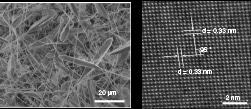Mar 19 2019
Scientists in China and at UC Davis have evaluated high conductivity in extremely thin layers of niobium arsenide, a kind of material known as a Weyl semimetal.
 Scanning electron micrograph of nanowires and nanobelts of niobium arsenide (left) and higher-magnification transmission EM of nanobelts. Niobium arsenide is a semimetal with interesting conductive properties at its surfaces. (Image credit: UC Davis)
Scanning electron micrograph of nanowires and nanobelts of niobium arsenide (left) and higher-magnification transmission EM of nanobelts. Niobium arsenide is a semimetal with interesting conductive properties at its surfaces. (Image credit: UC Davis)
According to Sergey Savrasov, Professor of Physics at UC Davis, a Weyl semimetal, at room temperature, has about thrice the conductivity of copper. Savrasov is a coauthor of this study, which has been published in Nature Materials on March 18th, 2019.
New materials that are conductors have attracted great attention among physicists and materials researchers, for fundamental research and due to their potential to lead to new types of electronic devices.
Savrasov has been working on theoretical condensed matter physics. In 2011, he, in collaboration with others, had suggested the existence of Weyl semimetals. The ability to manufacture and test small pieces, known as nanobelts, of niobium arsenide by the Chinese researchers substantiated the theoretical predictions. Typically, the nanobelts are two-dimensional because of their very thin nature.
A Weyl semimetal is not a conductor or an insulator, but something in between.
Sergey Savrasov, Professor of Physics, UC Davis.
For instance, niobium arsenide, which is a poor conductor in a larger volume, has a metallic surface with the ability to conduct electricity. Its surface is topologically protected, which means that it cannot be altered without breaking up the bulk material.
In many materials, the surfaces can be chemically changed by impurities that are gathered from the environment, which is a hindrance to conductivity, whereas topologically protected surfaces do not collect these impurities.
In theory we expect Weyl surfaces to be good conductors as they don’t tolerate impurities.
Sergey Savrasov, Professor of Physics, UC Davis.
Considering the electrons flow through a material, it is conceptualized that they bounce off or scatter from impurities. A conductive material, at the quantum level, has a Fermi surface, which gives the details of all the quantum energy states that electrons can occupy. This Fermi surface has an impact on the material’s conductivity.
The nanobelts examined in these experiments had a limited Fermi surface or Fermi arc, which means that electrons can only be scattered to a restricted range of quantum states.
“The Fermi arc limits the states electrons can bounce back to, therefore they are not scattered,” stated Savrasov.
Materials having high conductivity at very small scales are possibly useful for inventors who attempt to fabricate tiny circuits. The lesser the electrical resistance, the lesser the heat produced as current flows.
The coauthors of this research are Cheng Zhang, Zhuoliang Ni, Jinglei Zhang, Xiang Yuan, Yanwen Liu, Yichao Zou, Zhiming Liao, Yongping Du, Awadhesh Narayan, Hongming Zhang, Tiancheng Gu, Xuesong Zhu, Li Pi, Stefano Sanvito, Xiaodong Han, Jin Zou, and Faxian Xiu. The associated research institutions include Fudan University, Shanghai; Chinese Academy of Sciences, Hefei; Nanjing University of Science and Technology and Nanjing University, Nanjing; Beijing University of Technology; the University of Queensland, Australia; ETH Zurich, Switzerland; and Trinity College Dublin, Ireland.
The study received financial support from the National Natural Science Foundation of China and other Chinese government agencies, U.S. National Science Foundation, the Australian Research Council, and Science Foundation Ireland.